87 Ma May

Beez Neez now Chy Whella
Big Bear and Pepe Millard
Fri 19 Jan 2018 23:47
|
87 Ma May, Ha
Noi
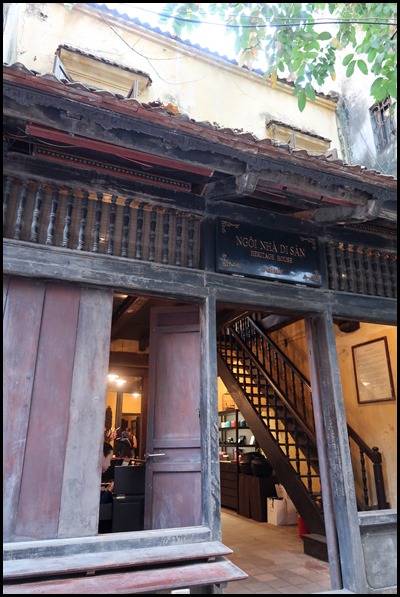 In our Lonely Planet book was a walking
tour map, off we went. After the Lake Pagoda we found 87 Ma
May, a traditional house. We paid out thirty one and a half pence and in
we went.
 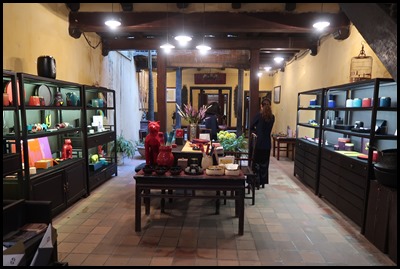 As we have come to expect in these old
houses, there was a shop at the front beyond the pay desk, but this used to be just so, and at
least the stuff on sale was bright and colourful – expensive though, so we went
beyond to the back of the house.
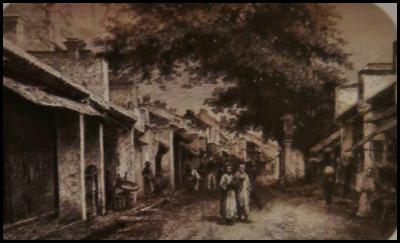 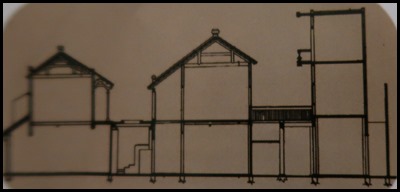 Our pamphlet showed us what the street looked like when the house was built and a
diagram of the house before restoration.
The pamphlet said: Ma May Street, once
located on the bank of the Red River, was a very lively commercial harbor. It
consisted of two small streets: Hang May and Hang Ma. Hang May, located
near the pier, specialized in the selling of rattan and bamboo products, Hang
Ma, close to Hang Bac Street, sold votive papers.
At the beginning of the 19th century,
the two streets were combined into Ma May Street.
In the French time, the street was
called Quan Co Den which means Black Flags Street. The traditional occupations
(rattan and votive papers) disappeared. In this street were many local and
foreign businessmen gathering to carry out their trading business, who than
settled down here together. From 1999,
the street changed a lot and became one of the more interesting streets of
Hanoi.
The house was built at the end of the
19th century. Shopkeepers’ families lived there successfully until 1945, when a
family bought it to sell herbal medicine.
In 1954, the government requisitioned
the house and five families settled down there until 1999. These people had
various occupations: grocer, tailor, state employee, martial arts
teacher.
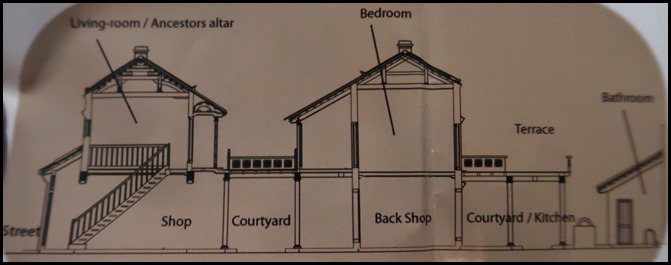 A diagram of the house layout showing
spatial organisation.
This house is typical of the
traditional architecture in the Old Quarter: it has a narrow facade and a
succession of buildings and courtyards, hence the popular reference as a
“tube-house”. The shop is located in the first building overlooking the street.
It is closed at night by removable wooden panels. On the second floor are the
living-room and ancestors’ altar, the most sacred place for the family.
The second building is dedicated to the
living area. The kitchen and bathroom are located at the far end of the house.
The two courtyards allows a good
ventilation and natural light in the house.
The house has been restored within the
cooperation agreement between Hanoi and Toulouse (France) cities and was
inaugurated on the 27th of October 1999. The structure elements in a good shape
as well as the traditional succession of buildings and courtyards have been
preserved. The modifications made by the former residents – partition of the
inner space, split of the shop front in two parts, new three floors building at
the back of the plot of land – were suppressed to give back the house its
original shape.
It was the first restoration of this
kind in the Old Quarter. Since then, the house helps to promote at local and
international levels the cooperation projects, and more specifically to present
Vietnamese architecture and building techniques (facade, inner house
organization). It was recognized as Vietnamese National Heritage in
2004.
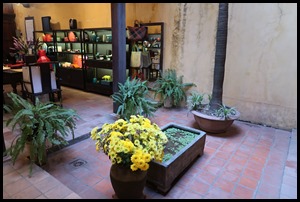 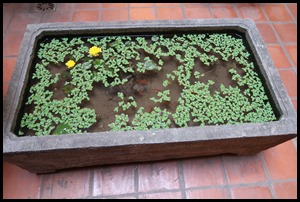  Beyond the shop was the first courtyard, a stone pond complete
with koi and then an open sitting
room.
 Loved the twin tables against the
wall, old
typewriter, telephone and ink wells.
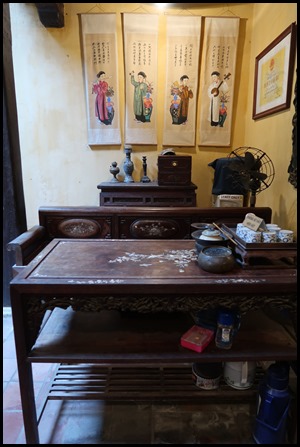 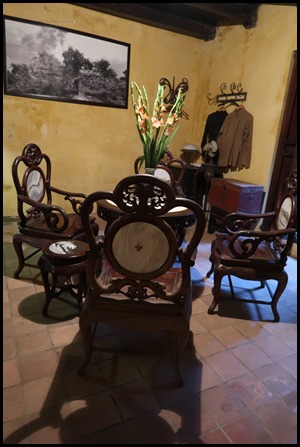 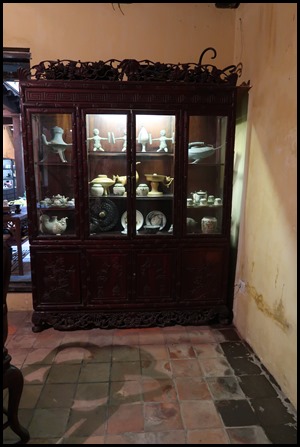 Behind the sitting
room was what was called on the pamphlet a ‘back shop’ but it is very
much laid out to be a dining room with a lovely
wall dresser filled with china serving plates and
ornaments.
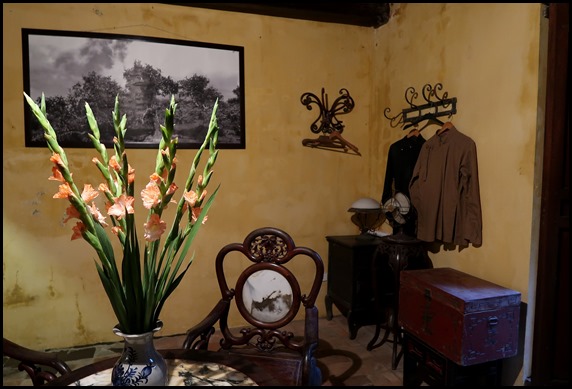 Quite homely in
its own fashion.
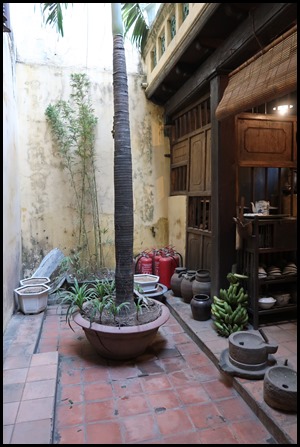 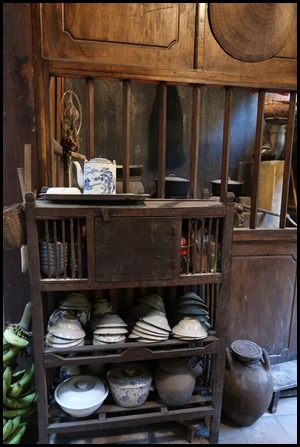 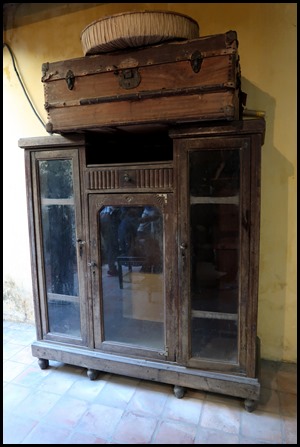 We stepped over a flood protection board
and out into a smaller courtyard. The kitchen dresser stood against the kitchen and in this room
was a really old dresser, old packing case and hat
box on top.
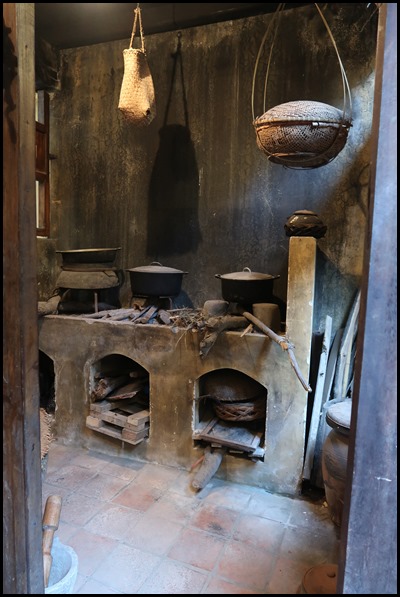 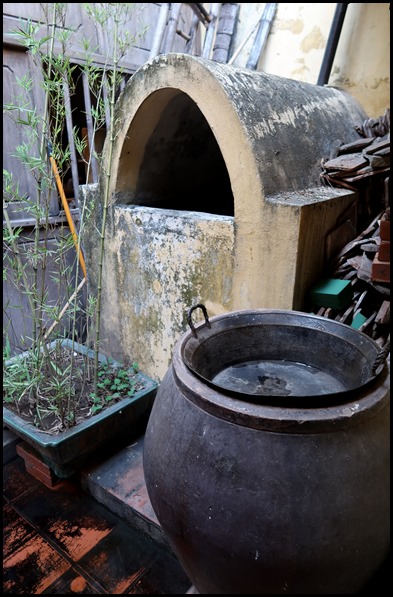 The kitchen and
beyond another small space was another oven with
access to a well. (Beyond this was a modern toilet with an old
fragrance......)
The Legend of Cong and
Tao: In each Vietnamese family, the kitchen is not only the place where they
cook meals every day but also a very important place in spiritual term.
Customarily, the stove tripod is called To, a deity who is assigned by God to
take care of the family. Before the family performs a ritual, they have to
report to Tao first, so he knows what they are going to do and then the ritual
is performed.
Tao is also called Tao Quan or Tho
Cong, the deity who takes care of every activity of the host family and prevents
the intrusion of evils into the family. Therefore, according to folk beliefs,
this deity is related to the family’s fortune.
According to folk beliefs, Tao
consists of three people, two men and a woman. In some places, Tao is known as
the king of the kitchen. Legend has it that a man called Trong Cao marries a woman called Thi Nhi. They have lived with
each other a long time but do not have children, so they become saddened and do
not get along with each other. One day, Trong Cao beats his wife. Thi Nhi gets angry so she leaves home
and meets Pham Lang, who she marries.
Trong Cao is
regretful. He quits his job and looks for his wife everywhere. He becomes a
beggar for his day-to-day survival. One day he goes to a home and begs for food.
The hostess gives him rice. Trong Cao
recognizes Thi Nhi, and she also recognizes him. They feel regretful. They begin
to talk to each other. Afraid that Pham Lang returns home and sees Trong Cao, Thi Nhi tells Trong Cao to hide in a pile of straw in the
garden while she tries to find a way to explain things to Pham
Lang.
Trong Cao is so tired he falls asleep
in the pile of straw. At that time, Pham Lang arrives home and remembers he does
not have ash for his paddy field. He sets fire to the straw. Seeing that, Thi
Nhi gets so emotional she jumps into the fire. Three of them, two men and a
woman, die in the fire. Appreciating their loyalty and love, God announces them
to Tao Quan. Pham Lang becomes Tho Cong, who takes care of the kitchen chores.
Trong Cao becomes Tho Dia, who takes care of household chores. Thi Nhi becomes
Tho Ky, who takes care of food shopping.
Traditionally, on the afternoon of the
22nd day of the twelfth lunar month, families perform rituals to see Tao Quan
off, so the next day they go to heaven to read his reports on everything about
the host family. They come back to the family at noon on the 30th day of the
twelfth lunar month to continue work for the new year.
Offerings on the Tho Cong altar
consists of a hat, shoes, ancestral tablets, a sugar cane (to be used as a
walking stick), and a live carp. After the ritual is finished, the fish will be
released into a river and will turn into a dragon which flies Tho Cong to the
heaven.
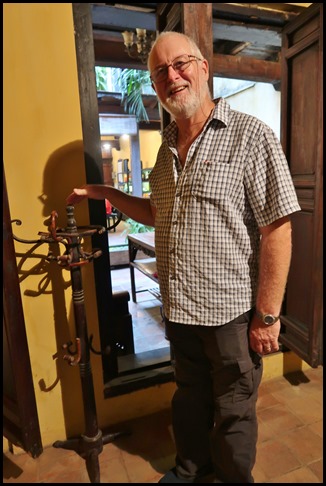  Quite wrung out after reading the legend
in the kitchen, I find Bear posing by a hat and coat stand,
trigger finger aloft..... Such diddy people here you know. I race to the steep, narrow stairs.
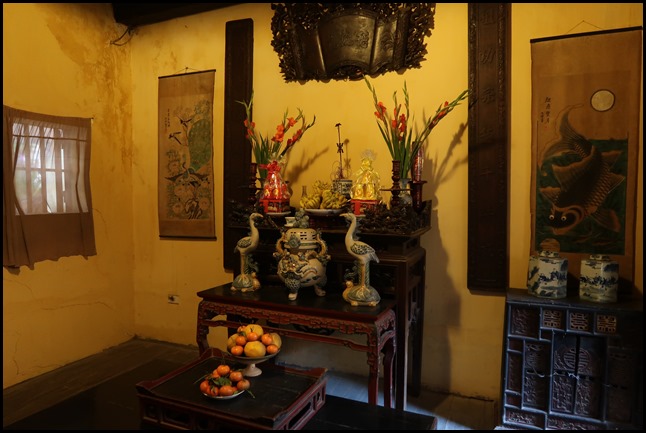 The ancestral
altar.
The Ancestral Altar:
Began with a four line verse. “Only trees with roots can grow green.
Only when water has its source are there large seas and deep rivers . Where are
people originated from? Because of their ancestors, they were
born.”
If one forgets to worship his or her
ancestors, he or she forgets his or her origin. Therefore, Vietnamese families,
whether they are in lowland or mountainous areas, in the city or the
countryside, and whether they are rich or poor, choose the most solemn place in
their houses to worship their ancestors. The altar is the bridge between living
people and the spiritual world and is a token of gratitude to
forefathers.
The ancestral altar consists of
ancestral tablets, familial records or portraits of deceased grandparents or
parents; incense and offerings are also placed here. For a person who has just
passed away, there must be a separate altar for him or her. After twenty seven
months, his or her tablet or photo is placed on the common
altar.
The Vietnamese believe that each
person has his or her soul. Death only takes away the body, but the soul stays
forever in the other world. The deceased still has an invisible connection with
their living relatives and subsequent generations. Souls can intervene in lives
in a magical way. The altar is the place where ancestors are invited back to the
home and witness their respect and prayers. During death commemorations,
holidays and important events of the family, there are rituals dedicated to
ancestors; the ritual performer prays in front of the altar. Ancestral
worshipping is a factor which brings family members together.
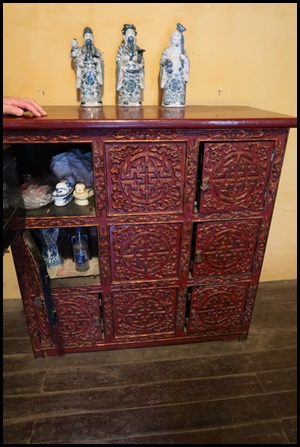 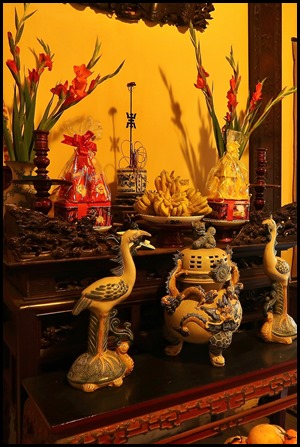 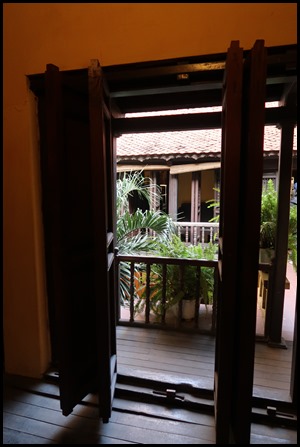 Bear liked the dresser to the left of the altar and happily had a nose in
the cupboards. I enjoyed the ornaments on the altar,
the shortbread biscuits in big tins were a bit of a surprise..... and then we
headed along the balcony to the
bedrooms.
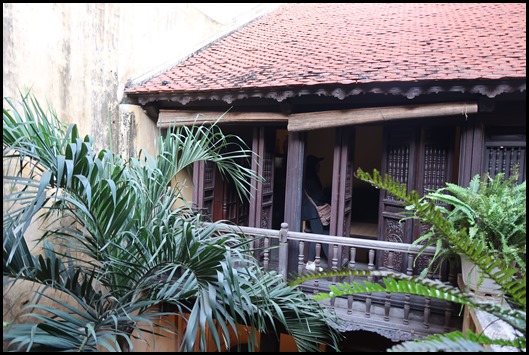 Looking toward the
bedrooms.
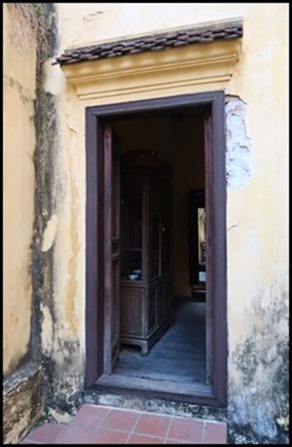 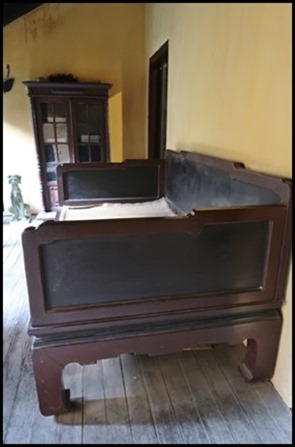 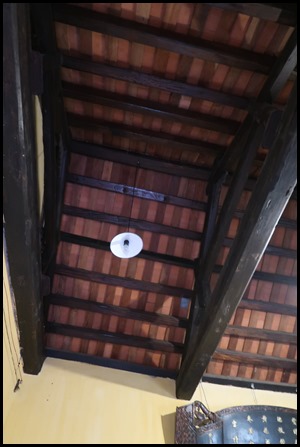 In through the door, (bit of damp to be sorted and a lick of paint needed)
a tiny bedroom with a very uncomfortable looking, heavy
wooden single bed. Lovely ceiling
though.
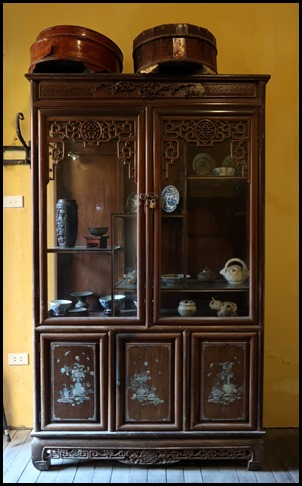 Behind us, I’m sure I’m getting a thing for
Chinese furniture.
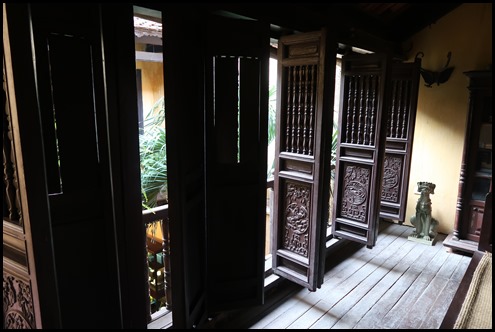 Sitting on the bed must have been nice to look out through the doors.
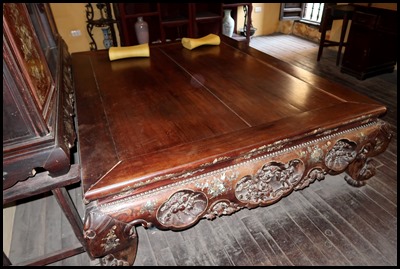 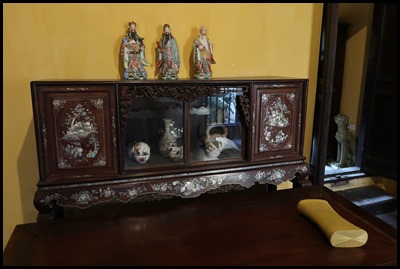 In the double bedroom a very ornate, but
equally uncomfortable looking bed, with very hard sausages for
pillows. A pretty glass-fronted bedside
cabinet though, inlaid with mother of pearl.
 To the far end of the room I really did
like the display shelf.
 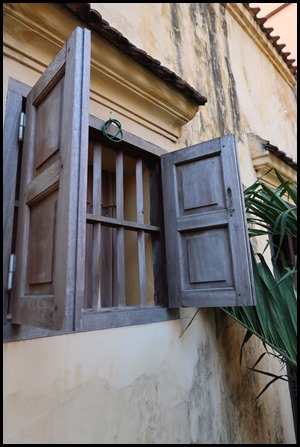 We stepped out into the
garden where Bear announced that he had found the
BBQ. Only him. We thought the bedroom
windows looked a bit austere.
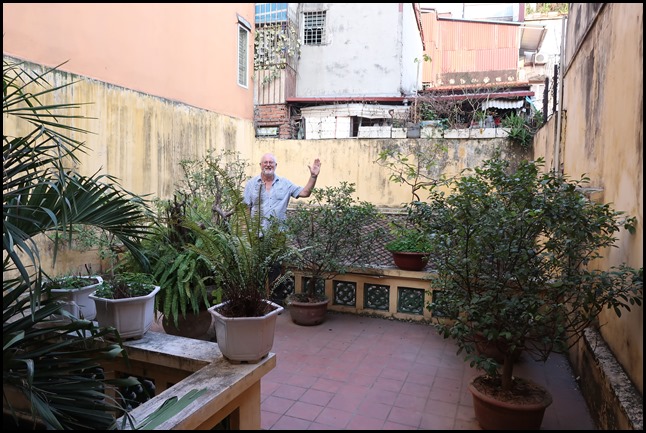 Lots of planters
and quite a lot of damp.
 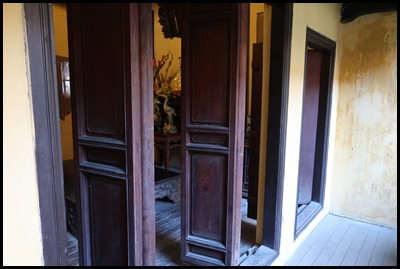 We did like the bonsai that had been taken over. Back down the length of
the house, in through the doors, back to the
ancestral altar room.
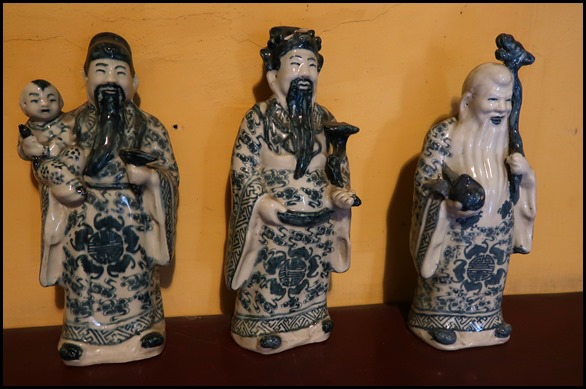 The chaps on the
dresser where Bear had rummaged were pleased to see
us........
  Starting to have a thing about lanterns. Back down the stairs showing how close the street is at the bottom.
ALL IN ALL LOVED SOME
OF THE FURNITURE
REALLY INTERESTING
|